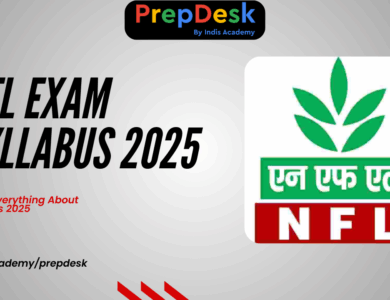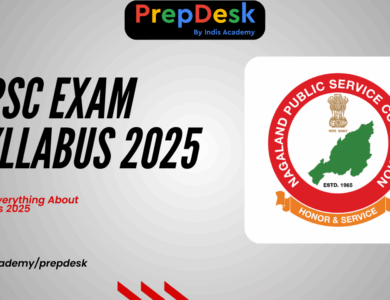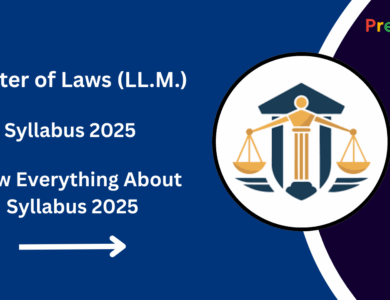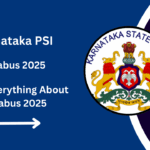SSC CPO 2025 Syllabus – Tier 1 & Tier 2 Subject-wise Topics & Exam Pattern
Prepare effectively for the SSC CPO 2025 exam with a detailed breakdown of the syllabus for Tier 1 and Tier 2. Understand the subjects, exam pattern, and marking scheme, and download the official syllabus PDF to guide your study plan.

The Staff Selection Commission (SSC) Central Police Organization (CPO) exam is one of the most sought-after recruitment exams for candidates aspiring to join the police forces like Delhi Police, CAPFs, and other Central Armed Police Forces. The SSC CPO exam tests candidates’ aptitude in reasoning, general knowledge, mathematics, and English language. To succeed, a thorough understanding of the detailed syllabus and exam pattern is essential.
SSC CPO Exam Overview
| Exam Stage | Subjects | Number of Questions | Total Marks | Duration |
|---|---|---|---|---|
| Paper I (Written) | General Intelligence & Reasoning, General Knowledge & Awareness, Quantitative Aptitude, English Comprehension | 100 | 200 | 2 Hours |
| Physical Efficiency Test (PET) | Physical fitness test as per category norms | – | Qualifying | – |
| Medical Examination | Medical fitness test | – | Qualifying | – |
| Paper II (English Language) | English Language and Comprehension | 50 | 100 | 1 Hour |
SSC CPO Syllabus 2025 – Subject-wise Detailed Topics with Descriptions
1. General Intelligence & Reasoning
This section tests your ability to analyze and solve problems logically and quickly, without relying on language skills. It assesses both verbal and non-verbal reasoning.
| Topic | Description | Questions | Marks |
|---|---|---|---|
| Analogies | Finding relationships between two pairs of words or figures. Example: Dog : Puppy :: Cat : ? | 5-6 | 5-6 |
| Similarities and Differences | Identifying common or different characteristics in objects, concepts, or figures. | 4-5 | 4-5 |
| Spatial Visualization | Understanding and manipulating shapes and figures mentally, such as identifying folded shapes or hidden figures. | 3-4 | 3-4 |
| Problem Solving | Solving puzzles and logical problems requiring reasoning and judgment. | 4-5 | 4-5 |
| Analysis | Breaking down information into components to understand structures or causes. | 4-5 | 4-5 |
| Judgment | Making decisions based on reasoning and available facts. | 3-4 | 3-4 |
| Decision Making | Choosing the best course of action from alternatives. | 3-4 | 3-4 |
| Visual Memory | Recalling visual details after short exposure to images or patterns. | 3-4 | 3-4 |
| Discrimination | Identifying differences or similarities between figures, patterns, or concepts. | 3-4 | 3-4 |
| Observation | Noticing and remembering details from pictures, patterns, or written content. | 3-4 | 3-4 |
| Relationship Concepts | Understanding relationships like family relations, number series, or coding-decoding. | 4-5 | 4-5 |
| Arithmetic Reasoning | Solving reasoning problems based on arithmetic operations and concepts. | 4-5 | 4-5 |
| Verbal and Figure Classification | Grouping words or figures based on common properties or themes. | 5-6 | 5-6 |
| Arithmetical Number Series | Identifying the pattern in a series of numbers and predicting the next numbers. | 5-6 | 5-6 |
| Non-Verbal Series | Recognizing sequences in shapes or patterns and predicting the next figure. | 5-6 | 5-6 |
2. General Knowledge and General Awareness
This section checks your awareness of the world around you, including current affairs, history, geography, and general science.
| Topic | Description | Questions | Marks |
|---|---|---|---|
| Current Affairs | Questions on recent national and international events, government policies, awards, and sports. | 10-15 | 10-15 |
| History of India | Indian history from ancient times to modern, including freedom movement and important personalities. | 5-6 | 5-6 |
| Indian Geography | Physical features, rivers, climate, and important locations in India. | 5-6 | 5-6 |
| Indian Polity and Constitution | Structure of the government, fundamental rights, duties, and important constitutional articles. | 5-6 | 5-6 |
| Economic Scene | Basic understanding of India’s economy, budget, banking, and economic reforms. | 3-4 | 3-4 |
| General Science | Basic concepts in physics, chemistry, biology, and everyday science. | 8-10 | 8-10 |
| Sports | Important sports events, players, and tournaments. | 2-3 | 2-3 |
| Awards and Honors | National and international awards in various fields like literature, peace, and science. | 2-3 | 2-3 |
| Books and Authors | Important books and their authors from various fields. | 2-3 | 2-3 |
| Important Dates | National and international days of significance and holidays. | 2-3 | 2-3 |
3. Quantitative Aptitude (Mathematics)
Tests basic math skills necessary for solving problems quickly and accurately in real-life situations.
| Topic | Description | Questions | Marks |
|---|---|---|---|
| Number Systems | Understanding types of numbers, their properties, and operations. | 5-6 | 5-6 |
| Computation of Whole Numbers | Performing addition, subtraction, multiplication, and division on whole numbers. | 5-6 | 5-6 |
| Decimals and Fractions | Working with decimal numbers and fractions, including conversions and operations. | 5-6 | 5-6 |
| Relationship Between Numbers | Understanding concepts like multiples, factors, LCM, and HCF. | 4-5 | 4-5 |
| Percentage | Calculating percentages, increase/decrease, and their applications. | 5-6 | 5-6 |
| Ratio and Proportion | Understanding and solving problems related to ratios and proportional relationships. | 4-5 | 4-5 |
| Square Roots | Calculating square roots and understanding their properties. | 3-4 | 3-4 |
| Averages | Finding averages (mean) from given data sets. | 4-5 | 4-5 |
| Interest | Calculating simple and compound interest in financial problems. | 4-5 | 4-5 |
| Profit and Loss | Solving problems related to buying, selling, profit, and loss. | 4-5 | 4-5 |
| Discount | Calculating discounts on products and sales prices. | 3-4 | 3-4 |
| Partnership Business | Solving problems on sharing profits and investments in partnership businesses. | 3-4 | 3-4 |
| Mixture and Allegations | Problems related to mixing different quantities and calculating resultant values. | 3-4 | 3-4 |
| Time and Distance | Solving problems involving speed, distance, and time calculations. | 4-5 | 4-5 |
| Time and Work | Problems on work done, efficiency, and time required. | 4-5 | 4-5 |
4. English Comprehension
Evaluates grammar, vocabulary, and understanding of written English.
| Topic | Description | Questions | Marks |
|---|---|---|---|
| Spotting Errors | Identifying grammatical or contextual errors in sentences. | 5-6 | 5-6 |
| Fill in the Blanks | Choosing the correct word or phrase to complete sentences meaningfully. | 5-6 | 5-6 |
| Synonyms and Antonyms | Finding words with similar or opposite meanings. | 5-6 | 5-6 |
| Spellings | Testing correct spelling of commonly confused or difficult words. | 5-6 | 5-6 |
| Idioms and Phrases | Understanding common idiomatic expressions and phrases in English. | 4-5 | 4-5 |
| One-word Substitution | Replacing a phrase or group of words with a single appropriate word. | 4-5 | 4-5 |
| Sentence Improvement | Correcting sentences to improve grammar and clarity. | 5-6 | 5-6 |
| Active and Passive Voice | Transforming sentences from active to passive voice and vice versa. | 4-5 | 4-5 |
| Direct and Indirect Speech | Converting direct speech to indirect speech and vice versa. | 4-5 | 4-5 |
| Para Jumbles | Rearranging sentences to form a coherent paragraph. | 5-6 | 5-6 |
| Reading Comprehension | Understanding and answering questions based on given passages. | 10-15 | 10-15 |
SSC CPO Exam Syllabus PDF Download
Download the complete SSC CPO syllabus in PDF format for easy reference and offline study:
Specialization / Posts Covered Under SSC CPO Exam
- Sub-Inspector (SI) in Delhi Police
- Sub-Inspector (SI) in Central Armed Police Forces (CAPFs)
- Assistant Sub-Inspector (ASI) in CISF
Recommended Books for SSC CPO Exam Preparation
- General Intelligence & Reasoning: Arihant’s General Intelligence & Reasoning
- General Knowledge: Lucent’s General Knowledge
- Quantitative Aptitude: R.S. Aggarwal’s Quantitative Aptitude
- English Language: Wren & Martin’s High School English Grammar & Composition
Preparation Tips for SSC CPO Exam 2025
- Understand the exam pattern and syllabus thoroughly before starting preparation.
- Make a daily study schedule allocating time for each subject and stick to it consistently.
- Practice previous year question papers and mock tests regularly to improve speed and accuracy.
- Focus on strengthening basics in reasoning, mathematics, and English grammar.
- Stay updated with current affairs, especially related to national and international events.
- Maintain physical fitness as per SSC CPO PET standards to clear the physical test stage.
- Revise regularly and identify weak areas for targeted improvement.
Conclusion
Cracking the SSC CPO exam requires consistent effort, smart preparation, and a clear understanding of the syllabus. By focusing on the detailed topics, practicing regularly, and maintaining physical fitness, aspirants can enhance their chances of success in this prestigious recruitment exam. Download the syllabus PDF and start your preparation today!





